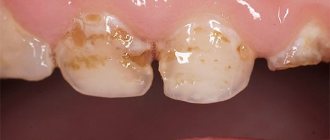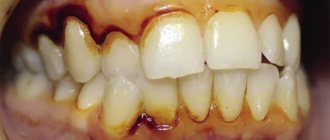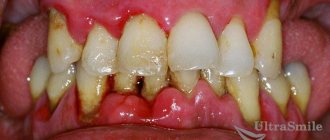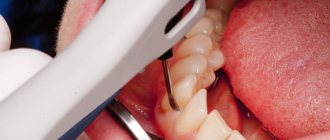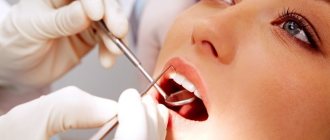Due to the high prevalence of periodontitis and periodontal disease among all segments of the population, the prevention of these diseases becomes especially important. It is very important to start preventing periodontal diseases from early childhood.
What does the prevention of periodontitis and periodontal disease consist of? Of course, first of all, regular dental and oral care is necessary. But not only! Other factors are also important for healthy teeth. Let us recall the main conditions for quality oral care.
Basic principles of prevention of periodontitis and periodontal disease
- Proper oral care.
- Regular visits to the dentist.
- Healthy eating.
- Sanitation of chronic foci of infection.
- Rejection of bad habits.
As you can see, the principles are known to everyone, they are simple and easy to implement. You just need to not be lazy and stick to them. Prevention of periodontal diseases can be local and general. Let us dwell in more detail on each principle of prevention.
Proper oral care for periodontal prevention
One of the main preventative measures to avoid periodontitis is careful oral care. If you follow basic rules, you can avoid problems with teeth, because the effectiveness of this method is close to 100%.
Now in pharmacies you can buy various auxiliary products for high-quality oral hygiene - irrigators, flosses, devices for cleaning the tongue, rinses, gel-pastes, sprays, individual special mirrors for teeth, chewing gum with various additives, care products for removable orthopedic and orthodontic designs and even safe, but very indicative dyes for identifying plaque at home. You can easily choose for yourself what you like best and is better suited for oral hygiene.
1. Brushing your teeth.
It is necessary to teach a child from an early age to brush their teeth correctly:
- Teeth should be brushed at least twice a day after meals, and even better after each meal;
- cleaning time should be up to two minutes;
- the movements of the brush should be as if cleaning.
2. Choosing the right toothbrushes.
The effect of brushing your teeth depends on the choice of toothbrush. Nowadays you can buy toothbrushes with different options. There are brushes that can be used to massage your gums while brushing your teeth. The height of the bristles can be different and provide cleaning in hard-to-reach places and between teeth. There are brushes that can clean your tongue. There are brushes with different thicknesses of bristles and with different numbers of rows, there are brushes with synthetic bristles and natural bristles, with different head sizes. There are even brushes that whiten teeth! What are the best, how to choose the right toothbrush?
The toothbrush is selected on the advice of the dentist. The doctor takes into account the condition of the gums and recommends a certain stiffness of the bristles. Usually a brush with medium-hard bristles is chosen; if the gums are easily injured and bleed, then use soft bristles.
Remember!
- the brush must be changed every 2-3 months, since its bristles wear off, plus microbes accumulate in it, and it becomes a breeding ground for infection throughout the mouth;
- after an infection, the brush should be changed in any case;
- after each brushing of your teeth, the brush should be thoroughly washed under running water, preferably with soap;
- the toothbrush should not be stored wet or in contact with other brushes;
- Toothbrushes should be stored with the head up, and not in cases;
- You should choose a brush with a rounded head so as not to injure the oral mucosa;
- It is better to purchase a toothbrush in pharmacies.
Electric toothbrushes represent a separate category. When using them, vibration movements are performed, thereby more thoroughly removing plaque from the teeth. Brushes can be powered by batteries. But with periodontal diseases, dentists do not recommend using electric toothbrushes. There are also sonic, ultrasonic, ionic and acoustic toothbrushes. They are not so popular, reviews about them are mixed, but their capabilities and quality are improving every year and we can expect that the demand for them will only increase. After all, for example, ultrasonic toothbrushes can neutralize the surface of teeth using ultrasound.
3. Caring for your mouth after eating.
It is advisable to rinse your mouth after each meal (if you cannot brush your teeth) and use additional personal hygiene products:
- floss (dental floss) is used to clean narrow interdental spaces before brushing your teeth, but only after consultation with a doctor who will evaluate the condition of your mouth; floss can injure sensitive areas of the gums, so many dentists treat dental floss with caution;
- a toothpick helps remove food debris from the interdental spaces, but it must be handled very carefully; if there are periodontal phenomena, it is better to avoid using them;
- if there are large gaps between the teeth, then they can be cleaned well with a stream of irrigator or special brushes;
- It is very good to rinse your mouth with dental elixirs (especially at night), but the elixirs must be changed so that the microflora does not become accustomed to the medicinal components;
- be sure to purchase an irrigator, which is simply necessary for dental care; irrigators create a stream of water, the pressure of which you can choose yourself; look for an irrigator with different attachments - for gums, for cleaning the tongue, interdental spaces, braces. Thanks to regular use of the irrigator, the gums become stronger, tartar forms less frequently, and cleaning the tongue also helps reduce the number of bacteria in the oral cavity. The stream of the irrigator washes away food debris that gets stuck under bridges and braces.
- a good preventative measure for periodontal disease is hydromassage of the gums using an irrigator, simple massage with fingers or interdental stimulators (rubber cones), regular massage trains the vessels of the gums and strengthens the maxillofacial apparatus;
- use of high-quality chewing gum - chewing gum is the minimum that is necessary after brushing your teeth, if it is not possible to brush your teeth and rinse your mouth after eating;
4. Choosing the right toothpaste.
Toothpaste must be of high quality, so it is better to purchase it at a pharmacy. Nowadays, toothpastes have different effects due to the active components included in their composition - bactericidal, strengthening, preventing the formation of plaque, reducing the sensitivity of the necks of teeth, whitening, etc. When choosing toothpaste, it is better to listen to the advice of your dentist, who will give individual recommendations after examining your teeth.
I. Conservative treatment
(all forms of gingivitis, initial stage of periodontitis)
— professional hygiene; - drug treatment; — training in personal hygiene.
Now let’s take a closer look at the treatment methods... Professional hygiene is a whole complex of measures based on 3 main stages:
- Removing dental plaque;
- Grinding and polishing;
- Fluorization is the strengthening of enamel.
Initially, stones and hard plaque are “beaten off” from the tooth and from under the gums using an ultrasonic nozzle (due to the vibration of thin metal plates when a low-voltage electrical signal is applied.) or special hand tools. This procedure, depending on the individual sensitivity of the patient, can be performed both under the influence of local anesthesia and without it. And it all ends with coating the teeth with fluoride varnish.
Regular visits to the dentist as periodontal prevention
1. Examination of the oral cavity.
Even if you don’t have dental problems, you should visit the dentist at least once every six months. In this case, during the examination, the doctor can detect the earliest symptoms of pathology of teeth and gums, see overhanging and chipped fillings, determine errors in crowns and bridges, and assess the presence of tartar. The dentist may suggest a session of fissure sealing or tooth remineralization
2. Cleaning from tartar.
When visiting the dentist, you should periodically brush your teeth to remove tartar. In modern clinics, teeth are cleaned quickly and painlessly using ultrasound, so there is no need to be afraid of this procedure. After cleaning teeth from stones, doctors polish the teeth so that plaque does not linger on their surface.
3. Timely treatment by an orthodontist and orthopedist.
If the patient has an incorrect bite, then it is necessary to correct it, since the likelihood of developing periodontal disease or periodontitis in this case is especially high. In the case of occlusion pathology, the distribution of the functional load on the teeth and alveolar processes changes. Risk factors include abnormal attachment of the labial frenulum and shallow vestibule of the oral cavity.
In modern dentistry there are many different methods for correcting dental pathology - these are braces and splinting. Currently, doctors can offer clasp orthopedic structures to suit any budget. If the patient uses removable orthodontic or orthopedic structures, they must be looked after especially carefully. Removable dentures should be washed and brushed daily. You can purchase special tablets for washing and disinfecting such structures.
Prosthetics are also considered to prevent periodontitis.
4. Remineralization of teeth.
To increase the strength of the enamel, your doctor may suggest treating your teeth with calcium and fluoride. This process is called remineralization. At home, you can saturate your teeth enamel with fluoride using special toothpastes and identical rinses. But, of course, professional remineralization is much more effective. Using a brush, a varnish containing high concentrations of fluoride is applied to the dried and clean tooth enamel. This varnish forms a film that, when dissolved, combines with the calcium of the enamel and strengthens it. Dentists advise combining home remineralization with low doses of fluoride with sessions of professional applications.
Healthy eating as a preventive measure for periodontal disease
1. Take coarse “solid” food more often.
To prevent periodontitis and periodontal disease, you need to consume more vegetables and fruits. The menu should not systematically include pureed dishes with a very soft consistency. If there is no solid food in the diet, then the periodontium is deprived of the necessary load. Active chewing is very beneficial. It strengthens the gums, promotes the proper formation and development of the dentofacial apparatus.
2. Avoid eating very hot and very cold foods.
It is known that contrasting temperatures destroy enamel, promoting the formation of cracks. Moreover, very cold and very hot food in itself is also harmful to enamel.
3. Don't forget about vitamins.
Don’t forget about vitamins, preferably natural ones. Therefore, the menu must contain products containing vitamins A, C, B, E. If it is not possible to buy fruits and berries in sufficient quantities, then it is necessary to take vitamins from the pharmacy.
4. There should be no snacks between meals.
If you really want to snack on something, then it is better to stop at a green apple or raw carrots. Buns, sweets, cookies, that is, products containing sugary substances, are dangerous and very harmful to teeth and gums. Therefore, even after eating one toffee or piece of chocolate, it is necessary to brush your teeth and rinse your mouth within the first 5 minutes after the snack.
Symptoms
Periodontitis occurs in several stages, and at each stage the symptoms may be different.
Initial. At this stage, inflammation is just beginning or periodontitis develops against the background of an acute form of gingivitis. There are almost no symptoms: the patient does not feel pain or discomfort, the gums look healthy, and there are no signs of inflammation. Periodontitis can only manifest itself as slight bleeding of the gums after injuries (with too active brushing, eating hard foods). This bleeding may seem natural, but if it occurs regularly, this is a reason to contact a periodontist.
Development of inflammation. The condition of the gums worsens: the mucous membranes lose density and become loose. At this stage, recession begins: the gingival margin drops, and it seems that the crowns have become longer. The interdental spaces may increase, and the crowns move in different directions. You may experience bad breath that does not go away even after brushing with toothpaste. Bleeding gums intensifies: it appears not only when brushing your teeth, but also while eating.
Spicy. Due to the active inflammatory process, pus begins to separate along with the blood when brushing teeth or eating food. The gingival margin continues to descend, exposing the root necks. The enamel becomes sensitive, severe pain occurs upon contact with temperature irritants, biting, or eating sweet or sour foods. The teeth gradually become looser, their mobility is noticeable and makes it difficult to eat solid foods. The gums become swollen and swollen. At this stage, there may be an increase in body temperature, the appearance of weakness, and a general deterioration in well-being.



